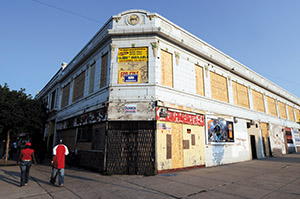Westward how?
By Mary Ruth Yoe
Photography by Dan Dry
Roughly 12,000 people populate the Washington Park neighborhood just west of the U of C campus, about a quarter of the residents it claimed 50 years ago. The population decline dates from the 1950s, when the Chicago Land Clearance Commission began tearing down buildings deemed blighted to make way for future development. That development never happened, and now some 1,000 vacant properties (one-third of them owned by the city) mark the landscape.
This past summer the University began acquiring a handful of those vacant properties. By early October it had purchased eight privately owned parcels, all on Garfield Boulevard between Martin Luther King Jr. Drive and Prairie Avenue, says Sonya Malunda, associate vice president for community and civic affairs. In addition, Malunda says, the University is under contract for two other properties and actively negotiating for five more. All told, the University expects to purchase about four acres.
 A boarded-up building along Garfield Avenue recalls Washington Parkís former grandeur.
A boarded-up building along Garfield Avenue recalls Washington Parkís former grandeur. The University’s interest, says Malunda, has both long-term roots and near-term opportunities. Looking two or more decades into the horizon, the parcels should provide room for campus expansion. With their proximity to the Green Line “L” and city-owned vacant properties that could be included in negotiations for new development, they also present an opportunity to help revitalize an area that serves as a gateway to Hyde Park.
In pursuing that near-term goal, the University hopes to develop the parcels—and perhaps some of those city-owned properties—in partnership with government and private developers, much as the University of Illinois–Chicago has partnered with the city and developers to build retail, condominiums, and dormitories in the surrounding Little Italy/Maxwell Street neighborhood.
What sorts of structures this development would contain—residences? retail? a research center?—remain to be seen. “Right now we mainly have a conceptual vision of what we could do within this corridor,” says Malunda. “The Green Line transit stop is there—is there an opportunity for transit-oriented development that would create jobs and provide community benefits?” Adding to the mix: Washington Park has the distinction of being the centerpiece of Chicago’s 2016 Olympics bid; the city proposes an Olympic stadium on 100 acres at the north end of the neighborhood’s namesake park.
In light of that prospect, the recent aquistions raised a few neighborhood eyebrows, including those of Third Ward Alderman Pat Dowell, AM’80, whose ward contains some of the parcels. Until September the University had bought its properties through a land trust, which veils the purchaser’s identity. In a September 12 Chicago Tribune article, Dowell expressed concern about the process, fearing that the University would hold onto the land in hopes that its value would increase if Chicago gets the Olympic nod in October 2009: “If we’re going to be partners and work together,” Dowell told the Tribune, “I have to be able to trust you and your word and your actions.”
But Associate Vice President for Public Affairs Robert Rosenberg describes the land trust as a standard precaution to keep speculators from driving up prices once they heard the University was buying property in the area. “The presence of a large institution can skew a negotiation,” Rosenberg says. “The practice of purchasing through a land trust is an attempt to provide for a market-based price.”
Meanwhile, Malunda is looking ahead: the next step, she says, is to “sit down with the alderman, the city, and the community to begin our planning of that particular area.”
That process has begun. Since joining the University in early October, Vice President for Civic Engagement Ann Marie Lipinski has had, she says, “some very productive conversations with Alderman Dowell and the Third Ward about how to launch a community-based planning process to help chart a future for those properties—and to think about how the University can help with partnerships to deliver priority programs to the neighborhood.”
Lipinski and Malunda addressed the Washington Park land purchases at a meeting of the 20th Ward, which also contains University-bought parcels, and Malunda plans to attend other community meetings in November and December. “Residents are concerned about gentrification, they’re concerned about the lack of affordable housing, they’re concerned that their neighborhood has so many vacant lots,” says Malunda. “These are things we will have to address.”
“We very much want to work with our neighbors on these questions,” Lipinski agrees. “I think it can be really great for the city, great for Washington Park, and great for the University.”
Return to top